Special Report
Least Healthy City in Every State

Published:
Last Updated:

Despite declining in each of the past two years, American life expectancy has improved significantly over the past several decades. The typical U.S. resident born today can expect to live 78.6 years, approximately five years longer than in 1980. While health outcomes have largely improved nationwide, some parts of the country are still stuck in the past, with life expectancy below 75 in some metropolitan areas.
Health behaviors and outcomes vary significantly throughout the United States. Many of the metropolitan-level health disparities parallel disparities in income and are affected by other environmental factors such as violent crime, the quality of schools, and access to fresh, healthy food.
To determine the least healthy city in every state, 24/7 Wall St. created an index composed of 35 health outcomes and health factors with data from the 2018 County Health Rankings & Roadmaps, a joint program of the Robert Wood Johnson Foundation and the University of Wisconsin Population Health Institute. In four states — Delaware, Rhode Island, New Hampshire, and Vermont — the lone metro area was listed as the least healthy by default.
Click here to see the full list of the least healthy city in every state.
Click here to see our detailed findings and methodology.

1. Gadsden, Alabama
> Premature death rate: 556.3 per 100,000
> Adult obesity rate: 36.8%
> Adult smoking rate: 23.1%
> Median household income: $41,152
Gadsden, Alabama is the least healthy metro area in one of the least healthy states. While nationwide 336 in every 100,000 Americans die before age 75, in Alabama, the premature death rate is 469 deaths per 100,000 residents, the third most of any state. In Gadsden, the premature death rate is even higher, at 556 in every 100,000 residents, the second highest premature death rate in Alabama and the third highest in the nation.
A number of environmental and socioeconomic factors may contribute to the negative health outcomes in Gadsden. Just 43.6% of metro area adults have access to opportunities for physical activity, the smallest share of any city in Alabama, and 34.2% do not exercise — the largest share. The typical household earns just $41,152 a year, one of the lowest median household incomes of any city nationwide.
[in-text-ad]

2. Anchorage, Alaska
> Premature death rate: 347.7 per 100,000
> Adult obesity rate: 28.6%
> Adult smoking rate: 15.8%
> Median household income: $82,203
Anchorage has the worst health outcomes of the two metro areas in Alaska. The city’s premature death rate of 348 per 100,000 residents is greater than the rate in the Fairbanks metro area of 330 premature deaths per 100,000 residents, yet less than the national rate of 336 premature deaths per 100,000 Americans.
Violent crime can induce physical and mental stress, discourage physical activity, and contribute to worse health outcomes overall. In 2016, there were 1,115 violent crimes reported per 100,000 residents in Anchorage, far more than the violent crime rate of 669 per 100,000 in Fairbanks and the second most of any U.S. metro area.

3. Lake Havasu City-Kingman, Arizona
> Premature death rate: 503.1 per 100,000
> Adult obesity rate: 30.4%
> Adult smoking rate: 20.0%
> Median household income: $42,423
While Phoenix, Prescott, and Tucson, Arizona are some of the healthier metro areas nationwide, the state is also home to one of the least healthy cities in the country. In the Lake Havasu City-Kingman metro area, 503 in every 100,000 residents die before age 75, the highest premature death rate in Arizona and the ninth highest of any U.S. city.
Lake Havasu City residents also report the worst health behaviors in Arizona by far. Some 20.0% of adult residents smoke, far more than the 14.7% state and 17.0% national smoking rates. While just 20.2% of adults throughout Arizona do not exercise — one of the smaller shares of any state — in Lake Havasu City some 30.1% of adults report no leisure-time physical activity, one of the largest shares of any U.S. metro area.
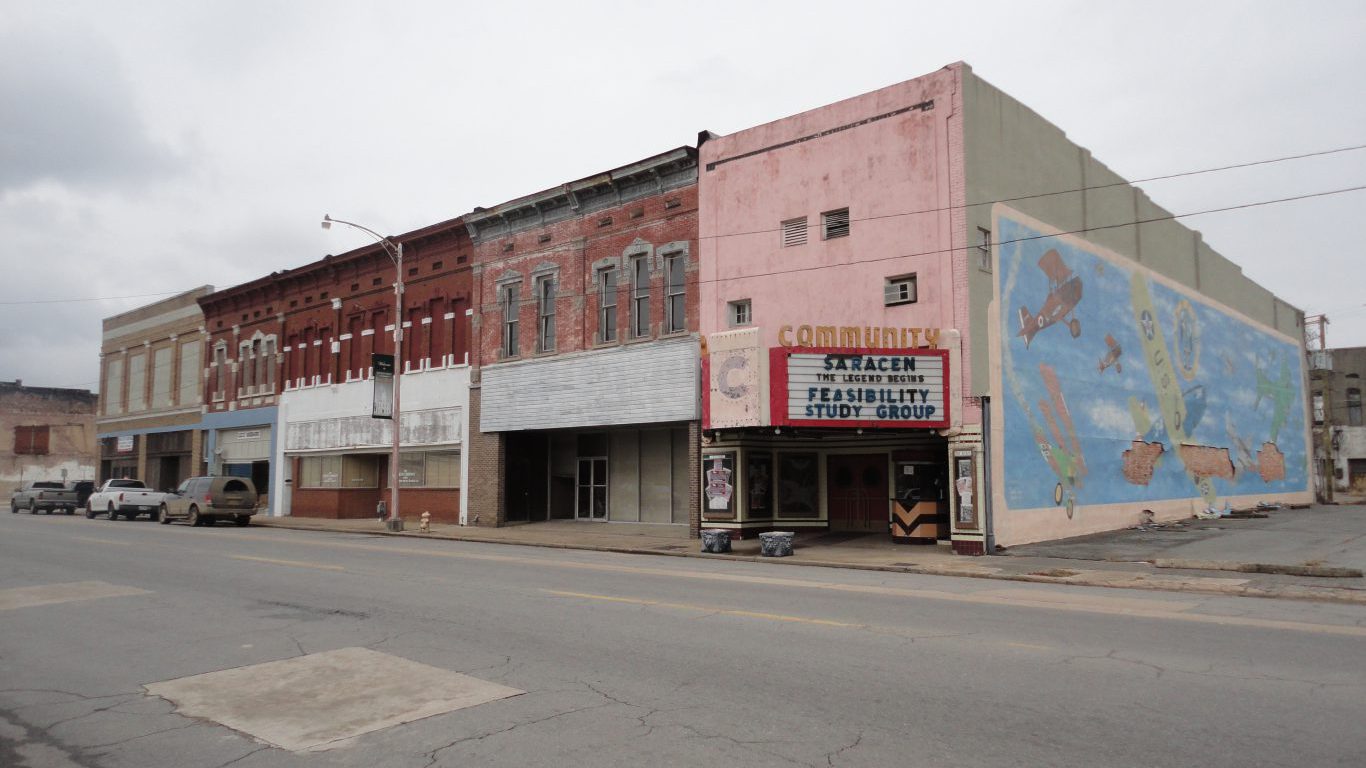
4. Pine Bluff, Arkansas
> Premature death rate: 537.8 per 100,000
> Adult obesity rate: 40.5%
> Adult smoking rate: 22.1%
> Median household income: $37,076
In Arkansas, one of the least healthy states, just one metro area has a lower incidence of premature death than the nation as a whole. Statewide, some 458 in every 100,000 residents die before age 75, the sixth highest premature death rate of any state and higher than the national figure of 336 per 100,000. In the Pine Bluff metro area, 538 in every 100,000 residents die before age 75, the highest premature death rate in Arkansas and fourth highest of U.S. cities.
People earning higher incomes have greater access to health care, can afford healthier food, may have more time to exercise, and have better health outcomes overall. In Pine Bluff, the typical household earns just $37,076 a year, the least of any city in Arkansas and over $20,000 less than the national median of $57,617. Some 21.8% of metro area residents live in poverty, the highest poverty rate of cities in the state and one of the highest in the nation.
[in-text-ad-2]
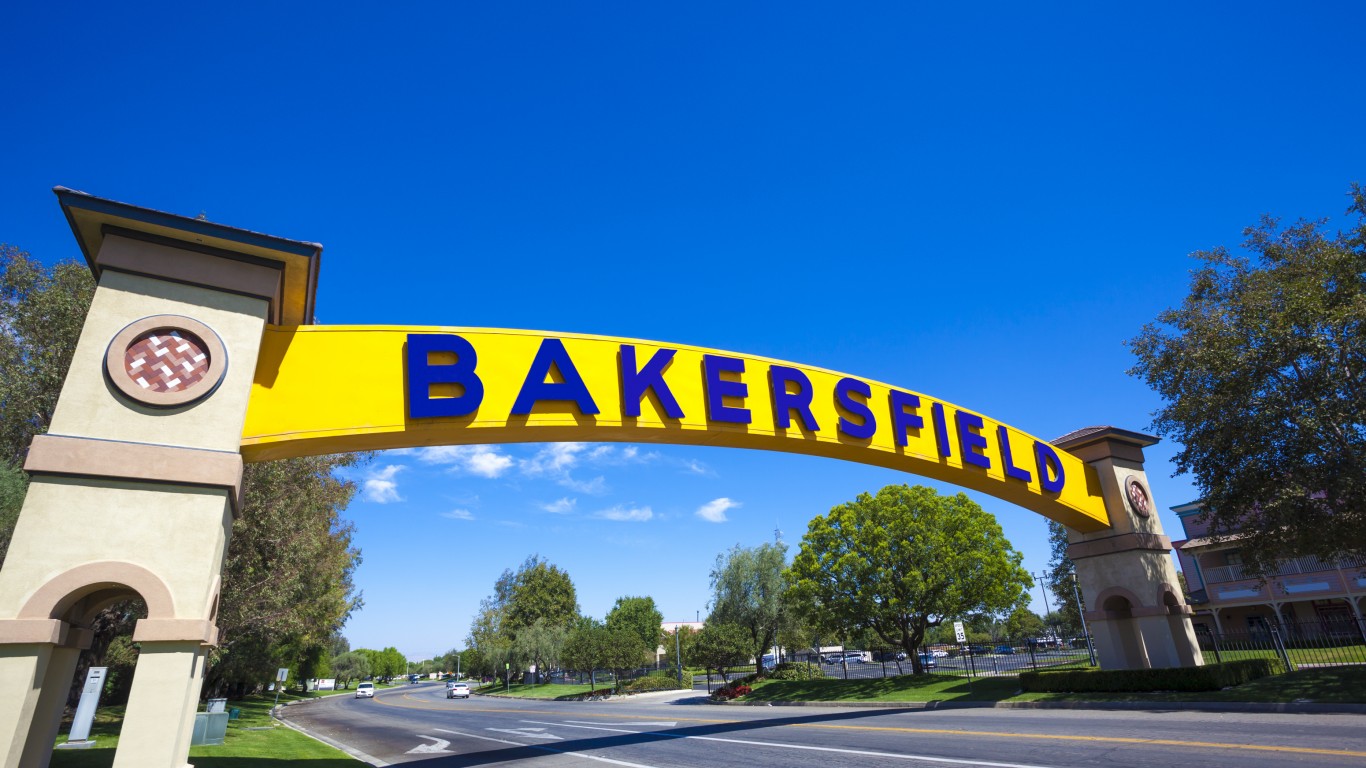
5. Bakersfield, California
> Premature death rate: 391.9 per 100,000
> Adult obesity rate: 31.6%
> Adult smoking rate: 16.2%
> Median household income: $49,903
While San Jose and San Francisco are some of the healthiest metro areas in the country, and California is one of the healthiest states overall, some cities in the state report far worse health outcomes than the nation as a whole. In Bakersfield, 392 in every 100,000 residents die before age 75, the third highest premature death rate in California and far higher than the state’s premature death rate of 269 in every 100,00 residents. Some 24.0% of adults in the area report being in fair or poor health, the fifth largest share in California and larger than the state’s share of 17.5%.
Bakersfield’s status as the least healthy city in California is largely due to its poor health behaviors. Some 16.2% of adults smoke and 23.6% of adults do not exercise, each the largest share in California — yet not far from the national smoking rate of 17.0% and inactivity rate of 23.0%.

6. Pueblo, Colorado
> Premature death rate: 418.2 per 100,000
> Adult obesity rate: 27.1%
> Adult smoking rate: 17.1%
> Median household income: $44,677
The least healthy city in one of the healthiest states, Pueblo is the only metro in Colorado where residents report worse health outcomes than the United States as a whole. In Pueblo, 418 in every 100,000 residents die before age 75, the highest premature death rate of cities in the state and far more than the national rate of 336 per 100,000 Americans. Some 22.1% of adults report feeling in fair or poor health, also the largest share in Colorado and far greater than the national share of 16.0%.
Health outcomes and behaviors in Colorado tend to vary by income. While the typical household in Boulder, the healthiest city in the state, earns $74,615 a year, the median household income in Pueblo is just $44,677 a year, the lowest of any Colorado metro area. Some 20.3% of the Pueblo population lives in poverty, the largest share in Colorado and far greater than the 11.0% poverty rate statewide.
[in-text-ad]

7. New Haven-Milford, Connecticut
> Premature death rate: 295.4 per 100,000
> Adult obesity rate: 27.0%
> Adult smoking rate: 13.6%
> Median household income: $66,176
Connecticut has some of the worst income inequality and the largest health disparities in the country. Residents in the state’s poorest and least healthy metro area, however, are still better off than the average American in a number of measures related to health and wellness. The typical household in the New Haven-Milford metro area earns $66,176 a year, the least of any city in Connecticut yet far above the national median household income of $57,617 a year.
People earning higher incomes have greater access to health care, can afford healthier food, may have more time to exercise, and have better health outcomes overall. In New Haven, 13.6% of adults smoke and 21.0% do not exercise, each the largest share of cities in the state, but still below the national shares. Some 295 in every 100,000 residents die before age 75, the highest premature death rate in Connecticut — yet far below the national rate of 336 deaths per 100,000 Americans.
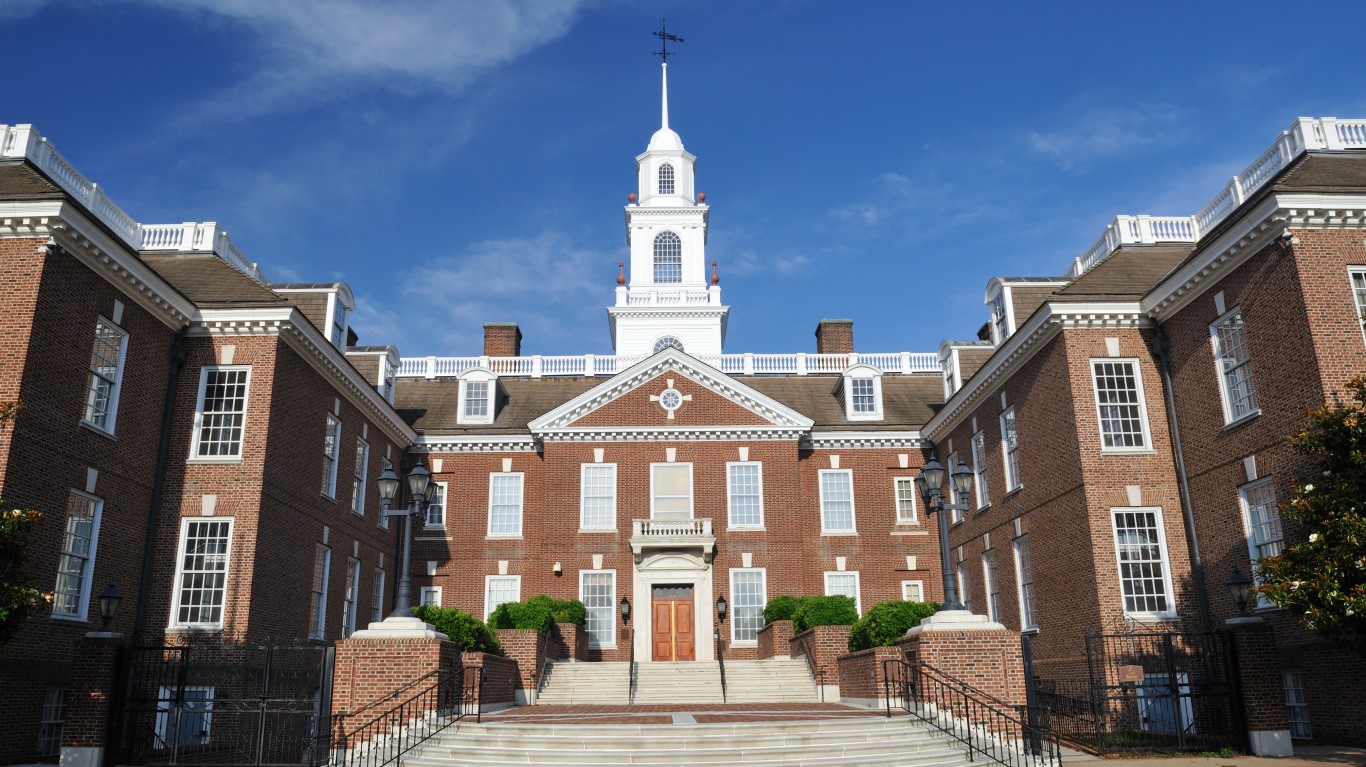
8. Dover, Delaware
> Premature death rate: 399.0 per 100,000
> Adult obesity rate: 33.6%
> Adult smoking rate: 18.2%
> Median household income: $54,140
While Dover is the only metro area in Delaware and is the least healthy city in the state by default, city residents still report worse health outcomes and behaviors than the state as a whole. Some 30.3% of Dover adults do not exercise, compared to the state inactivity rate of 26.1%. Similarly, 33.6% of adults are obese, more than the state obesity rate of 30.6%. Every year, 399 in every 100,000 Dover residents die before age 75, far more than the state premature death rate of 344 per 100,000 Delaware residents.
While the relationship is complicated, income is one of the largest determinants of health. The typical Dover household earns $54,140 a year, far less than the $61,757 median household income for Delaware.
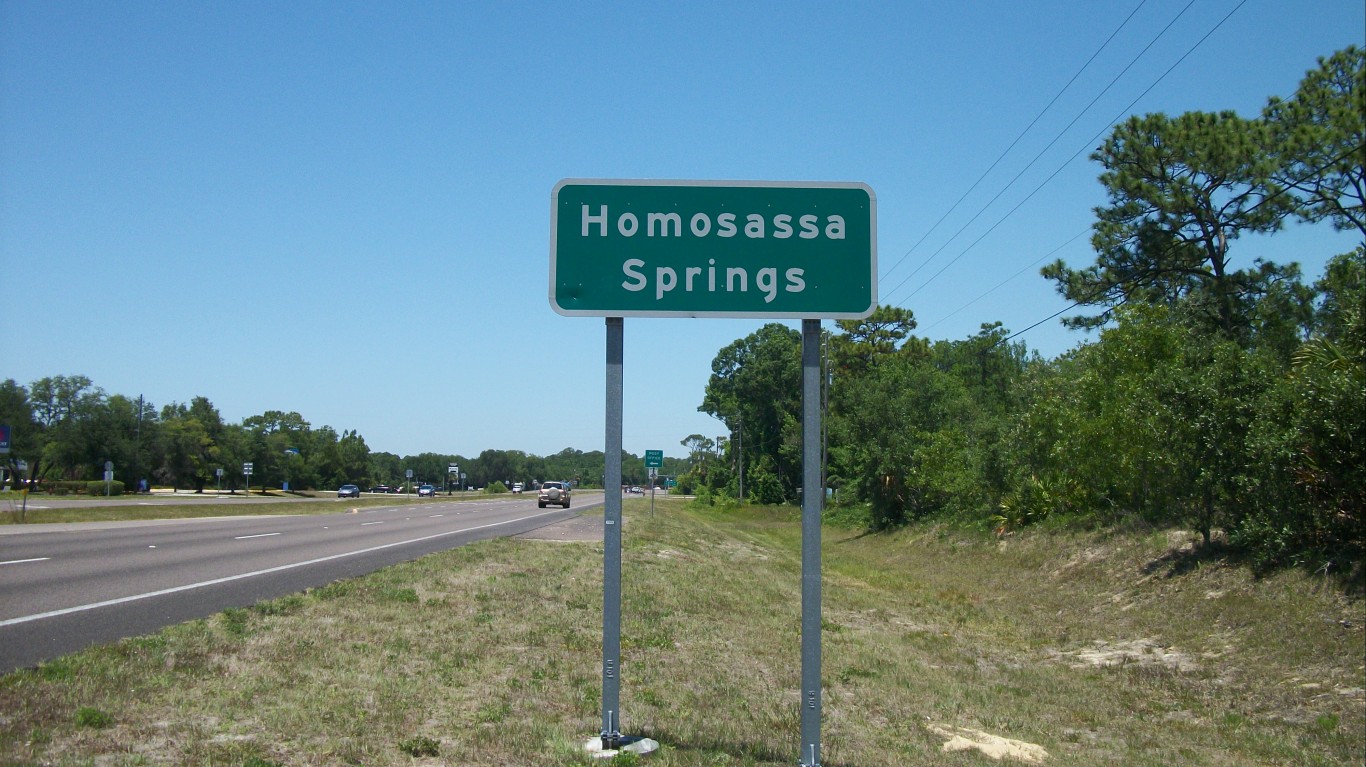
9. Homosassa Springs, Florida
> Premature death rate: 480.0 per 100,000
> Adult obesity rate: 27.1%
> Adult smoking rate: 18.4%
> Median household income: $39,206
In Homosassa Springs, 480 in every 100,000 residents die before age 75, the highest premature death rate in Florida and more than the statewide rate of 332 premature deaths per 100,000 residents. Poor health outcomes are likely the result of the city’s high incidence of unhealthy behavior. Smokers are more than 25 times as likely to get lung cancer than non-smokers, and are at a greater risk of dying prematurely. Additionally, adults who exercise seven hours a week are 40% less likely to die prematurely than those engaging in less than 30 minutes of exercise per week. Some 18.4% of Homosassa Springs adults smoke and 29.5% do not exercise, each the largest such share of cities in the state.
Income is a large determinant of health outcomes, and Homosassa Springs is one of the poorest metro areas in Florida. The typical household in the metro area earns $39,206 a year, the second lowest of any metro area in the Florida and approximately $18,000 less than the U.S. median household income.
[in-text-ad-2]
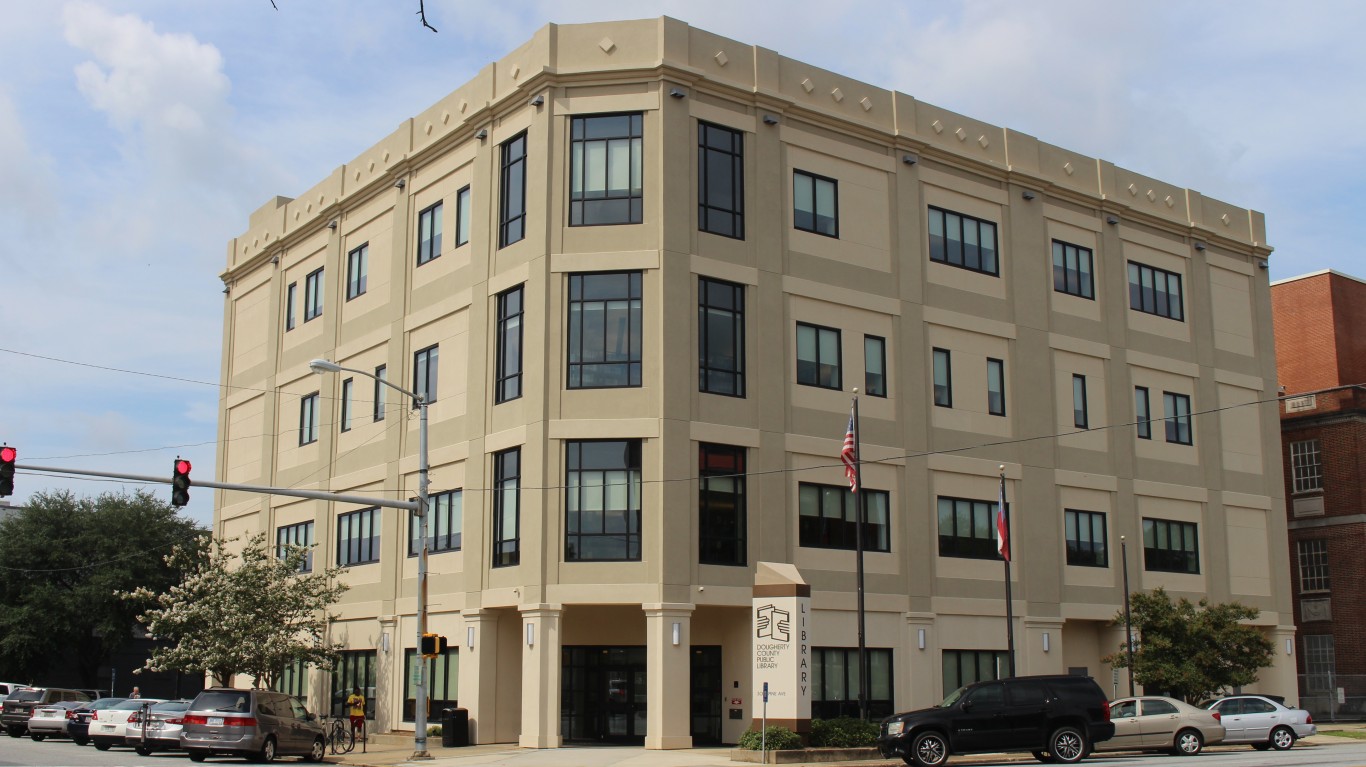
10. Albany, Georgia
> Premature death rate: 490.0 per 100,000
> Adult obesity rate: 34.8%
> Adult smoking rate: 20.6%
> Median household income: $40,667
As measured by a number of health outcomes and health behaviors, Albany is the least healthy metro area in Georgia. Some 20.6% of adults in Albany smoke, the largest share of any city in the state. Smokers are more than 25 times as likely to get lung cancer than non-smokers, and are more likely to die prematurely overall. Additionally, 34.8% of adults are obese, the second largest share in the state, which increases the risk of cardiovascular disease and diabetes. Every year, 490 in every 100,000 Albany residents die before age 75, the second highest premature death rate in Georgia.
A number of environmental and socioeconomic factors may contribute to the negative health outcomes in Albany. The metro area is highly rural, and just 58.4% of metro area residents have access to a opportunities for physical activity — by far the smallest share of cities in the state. Exposure to violent crime can also contribute to poor health outcomes as it can induce mental stress, physical stress, and discourage outdoor recreational opportunities. In 2016, there were 735 violent crimes reported per 100,000 city residents, the most of any city in Georgia and the 19th highest violent crime rate in the United States.

11. Kahului-Wailuku-Lahaina, Hawaii
> Premature death rate: 275.0 per 100,000
> Adult obesity rate: 22.9%
> Adult smoking rate: 13.3%
> Median household income: $72,268
The Kahului-Wailuku-Lahaina metro area is the least healthy of the two metro areas in Hawaii.
The city’s premature death rate of 275 per 100,000 residents is greater than the rate in the Honolulu metro area of 270 premature deaths per 100,000 residents, yet less than the national rate of 336 per 100,000 Americans. Various health behaviors may contribute to the slight health disparities between the two metro areas. In Kahului, 13.3% of adults smoke, more than Honolulu’s smoking rate of 11.2%.
Differences in wealth may also partially explain the health disparities. The typical household in Kahului earns $72,268 a year, less than $80,513, the median household income in Honolulu yet far more than $57,617, the national median income.
[in-text-ad]

12. Pocatello, Idaho
> Premature death rate: 390.7 per 100,000
> Adult obesity rate: 27.8%
> Adult smoking rate: 15.9%
> Median household income: $48,429
The least healthy city in a relatively healthy state, Pocatello is the only metro area in Idaho with worse health outcomes than the U.S. as a whole. Some 391 in every 100,000 Pocatello residents die before age 75 every year, far more than the statewide premature death rate of 307 per 100,000. Some 16.9% of adults in the metro area report being in fair or poor health, the largest share of cities in the state.
While Pocatello has the worst health outcomes in Idaho, behaviors in the metro area are comparatively healthy. Just 18.7% of adults in the city do not exercise, less than the state inactivity rate of 20.2% and the second smallest share of any city in Idaho. Just 27.8% of adults in the city are obese, the second smallest share of any Idaho metro area and less than the state obesity rate of 28.6%.

13. Danville, Illinois
> Premature death rate: 494.6 per 100,000
> Adult obesity rate: 34.2%
> Adult smoking rate: 18.0%
> Median household income: $45,481
Just 71.8% of the Danville metro area population has adequate access to opportunities for physical activity, the smallest share in Illinois. Inadequate access to exercise facilities may partially contribute to the city’s high inactivity rate. Some 28.1% of Danville adults do not exercise, and 34.2% are obese, each the largest share of any city in Illinois.
Lack of healthy behaviors among Danville adults likely contributes to the poor health outcomes in the area. While 17.2% of adults throughout Illinois report being in fair or poor health, 18.9% of adults in Danville do — the largest share of any city in the state. Every year, 495 in every 100,000 residents in the metro area die before age 75, the highest premature death rate in Illinois and far above the state rate of 324 premature deaths per 100,000 residents.

14. Terre Haute, Indiana
> Premature death rate: 461.9 per 100,000
> Adult obesity rate: 32.4%
> Adult smoking rate: 21.2%
> Median household income: $46,951
Terre Haute is a metro area of approximately 170,000 residents located about 70 miles west of Indianapolis. The typical household earns $46,951 a year, less than the median household income of $52,314 for Indianapolis as a whole and the fourth least of any city in the state. Some 15.5% of residents live in poverty, more than the state and national poverty rates of 14.1% and 14.0%, respectively.
People earning higher incomes have greater access to health care, can afford healthier food, may have more time to exercise, and have better health outcomes overall. In Terre Haute, 29.1% of adults do not exercise and 21.2% smoke, respectively the largest and third largest such shares in Indiana. For every 100,000 residents in Terre Haute, 462 die before age 75, far more than the premature death rate of 392 per 100,000 residents for Indiana as a whole and the second highest of any city in the state.
[in-text-ad-2]

15. Davenport-Moline-Rock Island, Iowa
> Premature death rate: 330.2 per 100,000
> Adult obesity rate: 31.9%
> Adult smoking rate: 16.3%
> Median household income: $52,590
The poorest and least healthy city in Iowa, the Davenport-Moline-Rock Island metro area is a city of approximately 383,000 residents located on the Iowa-Illinois border. The typical household in Davenport earns $52,590 a year, less than the median household income of $56,247 for Iowa as a whole and the lowest of any city in the state. Some 14.5% of residents live in poverty, far higher than the state poverty rate of 11.8%.
While the relationship is complicated, poorer areas tend to have worse health outcomes. Adults in Davenport report an average of 3.5 mentally unhealthy days and 3.4 physically unhealthy days a month, each the most of any city in Iowa. For every 100,000 residents in Davenport, 330 die before age 75, a higher premature death rate than Iowa’s as a whole of 313 per 100,000 residents and the second most of any metro area in the state.

16. Wichita, Kansas
> Premature death rate: 388.7 per 100,000
> Adult obesity rate: 33.5%
> Adult smoking rate: 18.5%
> Median household income: $53,663
The typical household in the Wichita metro area earns $53,663 a year, less than the median household income of $54,935 for Kansas as a whole. Additionally, 14.0% of city residents live in poverty, above the 12.1% state poverty rate.
The income disparity between Wichita and Kansas may partially account for the health disparities between the city and the state. Some 24.9% of adults in Wichita do not exercise, and 33.5% are obese, each the second largest share of any Kansas metro. Wichita also has the highest smoking rate of cities in the state, with 18.5% of adults reporting a smoking habit. Smokers are more than 25 times as likely to get lung cancer than non-smokers, and are at a greater risk of dying prematurely. Every year, 389 in every 100,000 residents die before age 75, far above the state premature death rate of 346 per 100,000 residents.
[in-text-ad]

17. Bowling Green, Kentucky
> Premature death rate: 428.4 per 100,000
> Adult obesity rate: 32.7%
> Adult smoking rate: 20.2%
> Median household income: $45,649
Rural areas face unique health problems and are often less healthy than urban areas. While the Bowling Green metro area is the least healthy city in Kentucky, residents are better off than the majority of residents of the relatively rural state according to a number of health metrics. While the city’s premature death rate of 428 deaths per 100,000 residents is the highest of any metro area in Kentucky, it is still lower than the state rate of 467 premature deaths per 100,000 residents. Additionally, while the city’s 32.7% obesity rate is the second highest of any Kentucky metro area, it is still below the 33.7% state obesity rate.

18. Monroe, Louisiana
> Premature death rate: 472.2 per 100,000
> Adult obesity rate: 34.9%
> Adult smoking rate: 22.5%
> Median household income: $38,004
Monroe is the least healthy city in one of the least healthy states. Adults report an average of 4.4 mentally unhealthy days and 4.2 physically unhealthy days per month, each the most of any city in the state. Some 20.3% of Monroe adults report fair or poor health, the second largest share in Louisiana.
A number of environmental and socioeconomic factors may contribute to the negative health outcomes in Monroe. The typical household in Monroe earns just $38,004 a year, the lowest median household income in Louisiana and the seventh lowest nationwide. Poorer areas tend have less access to exercise opportunities like parks and gyms, and just 68.8% of Monroe residents have access to locations for physical activity — the smallest share of cities in the state. Violent crime can also induce physical and mental stress, discourage physical activity, and contribute to worse health outcomes overall. In 2016, there were 1,187 violent crimes reported per 100,000 residents in Monroe, the highest violent crime rate nationwide.

19. Lewiston-Auburn, Maine
> Premature death rate: 356.6 per 100,000
> Adult obesity rate: 33.9%
> Adult smoking rate: 18.8%
> Median household income: $49,081
The Lewiston-Auburn metro area is the least healthy of the three metro areas in Maine. Some 23.9% of adults in the city do not exercise, and 33.9% of adults are obese, each the largest share in Maine and above the national inactivity rate of 23.0% and obesity rate of 28.0%. . Metro area adults report an average of 4.3 mentally unhealthy days per month, the most of the three cities in Maine. Every year, 356 in every 100,000 Lewiston residents die before age 75, far more than the state premature death rate of 328 deaths per 100,000 Maine residents.
Poorer areas tend to report worse health outcomes, and Lewiston is far less wealthy than Maine as a whole. The typical household in Lewiston earns $49,081 a year, less than the state median household income of $53,079 a year.
[in-text-ad-2]

20. Cumberland, Maryland
> Premature death rate: 418.0 per 100,000
> Adult obesity rate: 35.2%
> Adult smoking rate: 17.4%
> Median household income: $45,808
Maryland has some of the highest income inequality in the country, which contributes to large health disparities throughout the state. The typical household in the Cumberland metro area earns $45,808 a year, nearly $33,000 less than the median household income in the California-Lexington Park metro area, the wealthiest city in Maryland. Additionally, 16.1% of residents live in poverty, the highest poverty rate in Maryland and far above the 9.7% state rate.
People earning higher incomes have greater access to health care, can afford healthier food, may have more time to exercise, and have better health outcomes overall. In Cumberland, 27.1% of adults do not exercise and 35.2% of adults are obese, each the largest such share of any city in Maryland. Every year, 418 in every 100,000 residents die before age 75, far above the state premature death rate of 326 per 100,000 residents and the most of any city in Maryland.

21. Springfield, Massachusetts
> Premature death rate: 313.1 per 100,000
> Adult obesity rate: 25.7%
> Adult smoking rate: 17.1%
> Median household income: $54,855
Nationwide, Massachusetts has some of the worst income inequality, which contributes to large health disparities throughout the state. The typical household in Springfield, the poorest metro area in the state, earns $54,855 a year, approximately $28,000 less than in Boston, the wealthiest metro area. Some 15.6% of Springfield residents live in poverty, far more than the statewide poverty rate of 10.4% and the highest of any Massachusetts metro area.
Adults report an average of 4.0 physically unhealthy days per month, the most of any city in Massachusetts. Similarly, 16.4% of adults report being in fair or poor health, also the most of any city in the state. Every year, 313 in every 100,000 residents die before age 75, compared to the state premature mortality rate of 279 deaths per 100,000 residents.
[in-text-ad]
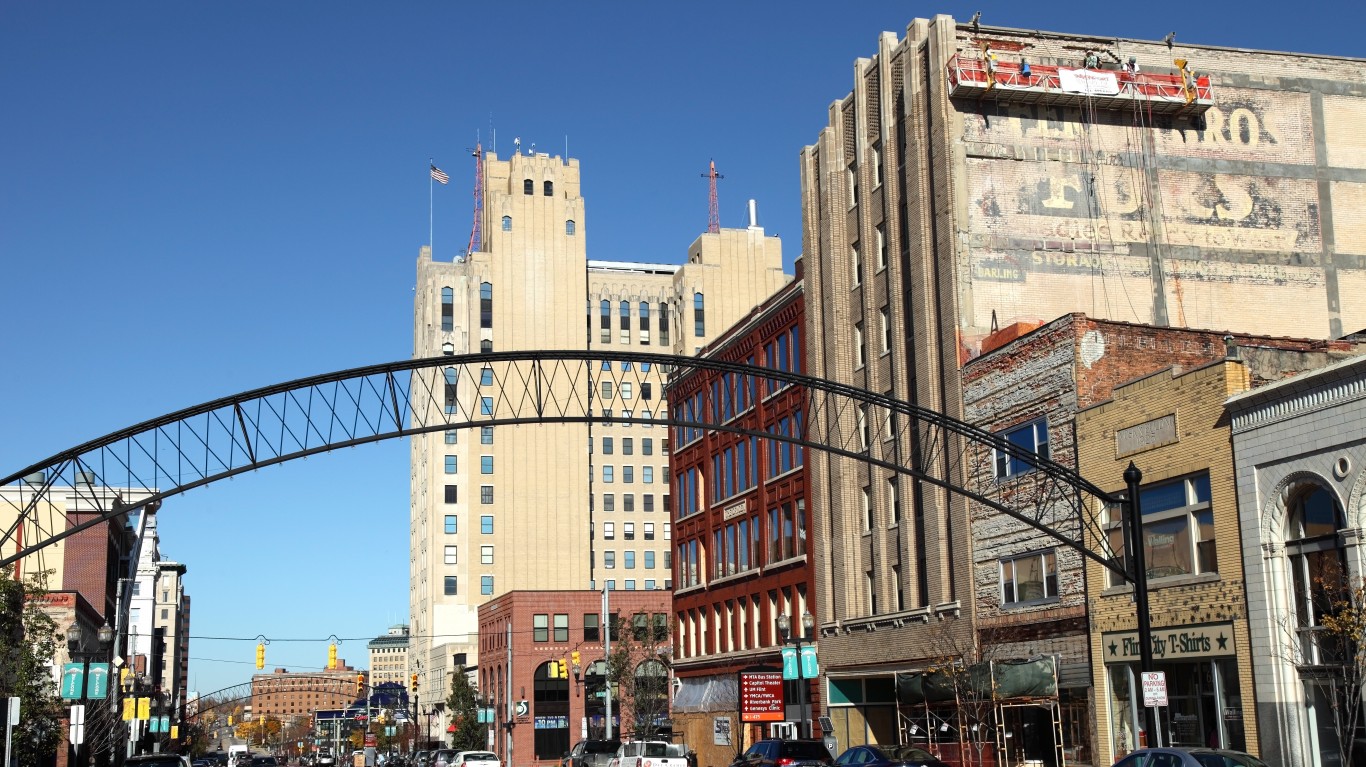
22. Flint, Michigan
> Premature death rate: 461.4 per 100,000
> Adult obesity rate: 31.2%
> Adult smoking rate: 20.8%
> Median household income: $43,955
In recent years, Flint has become emblematic of the inequality in the distribution of government services between rich and poor areas. Flint, one of the poorest metro areas nationwide, began using insufficient water treatment after it switched its water supply in April 2014 as a means to save money. As a result, lead seeped into the water supply, putting an estimated 100,000 city residents at risk of anemia, weakness, brain damage, and other negative health outcomes. The water has yet to return to drinkable quality. Today, some 18.5% of Flint households struggle with at least one of four major housing problems — overcrowding, high housing costs, lack of kitchen facilities, and lack of plumbing facilities — the largest share in Michigan. Also, a state high 31.4% of children live in poverty.
Flint residents report some of the worst health outcomes in Michigan. Approximately one in five adults reports being in fair or poor health, and 461 in every 100,000 residents die before age 75 — each the highest such figure of any city in the state.

23. Duluth, Minnesota
> Premature death rate: 335.7 per 100,000
> Adult obesity rate: 28.5%
> Adult smoking rate: 17.6%
> Median household income: $51,294
While Duluth is the least healthy city in Minnesota, it is still healthier than the United States as a whole by a number of measures. Some 21.0% of adults report no physical activity, the largest share in Minnesota yet lower than the 23.0% national inactivity rate. Adults report an average of 3.3 mentally unhealthy days and 3.6 physically unhealthy days per month, the most of any city in the state. Nationwide, however, U.S. adults report an average of 3.8 mentally unhealthy days and 3.7 physically unhealthy days per month. Every year, 336 in every 100,000 residents in Duluth die before age 75, the highest premature death rate of any city in Minnesota and equivalent to the national rate of 336 premature deaths per 100,000 Americans.

24. Jackson, Mississippi
> Premature death rate: 451.2 per 100,000
> Adult obesity rate: 33.9%
> Adult smoking rate: 18.2%
> Median household income: $50,632
Rural areas face unique health problems and are often less healthy than urban areas. While the Jackson is the least healthy metro area in Mississippi, the city’s residents are better off than the majority of residents of relatively rural state according by a number of health metrics. While the city’s adult inactivity rate of 32.3% is the highest in the state, it is still below the physical inactivity rate for Mississippi as a whole of 34.0%. Additionally, 19.6% of adults in Jackson report being in fair or poor health — the largest share of the three metro areas in the state yet far below the 22.2% of adults who report fair or poor health throughout Mississippi.
[in-text-ad-2]

25. St. Joseph, Missouri
> Premature death rate: 415.2 per 100,000
> Adult obesity rate: 32.8%
> Adult smoking rate: 23.1%
> Median household income: $49,211
St. Joseph is the least healthy city in Missouri. More than one in five adults in St. Joseph report being in fair or poor health, a much greater share than the 18.5% of adults who report the same in Missouri and the fifth largest share nationwide. Adults in St. Joseph also report high numbers of physically unhealthy days. In the last month, adults in this city said they felt physically unhealthy an average of 4.7 days, the most of any city in the state.
Many factors contribute to poor health, including smoking and lack of exercise. About 23.1% of adults in St. Joseph currently smoke, the third largest smoking rate nationwide and the largest of any city in the state. Nearly 30% of St. Joseph adults lead sedentary lifestyles, the largest inactivity rate of cities in the state and 10th largest share nationwide.

26. Great Falls, Montana
> Premature death rate: 377.5 per 100,000
> Adult obesity rate: 27.3%
> Adult smoking rate: 18.4%
> Median household income: $45,138
While Great Falls is the least healthy city in Montana, it is still healthier than the United States as a whole by a number of health metrics. The metro area’s 27.3% adult obesity rate, for example, is the highest of cities in the state yet still below the national obesity rate of 28.0%. Additionally, 14.7% of adults in Great Falls reports being in fair or poor health, the largest share in Montana yet lower than the 16.0% national figure.
People earning higher incomes have greater access to health care, can afford healthier food, may have more time to exercise, and have better health outcomes overall. In Great falls, the typical household earns just $45,138 a year, the lowest median household income in Montana and less than the national median of $57,617 a year.
[in-text-ad]

27. Grand Island, Nebraska
> Premature death rate: 316.9 per 100,000
> Adult obesity rate: 32.7%
> Adult smoking rate: 15.6%
> Median household income: $55,435
Grand Island, one of the most populous cities in Nebraska, may be least health city in the state, but it is comparatively healthier than the United States as a whole by several health metrics. For example, adults in Grand Island report on average some of the lowest physically and mentally unhealthy days each month among cities nationwide. Grand Island adults only report an average of 3.0 days of poor mental and physical health each month.
The city’s 15.6% adult smoking rate is considered the second highest share in Nebraska but lower than the nationwide smoking rate of 17.0%. Maintaining good mental and physical health as well as choosing to avoid smoking cigarettes has likely contributed to the city’s low premature death rate. Every year, 317 per 100,000 residents in Grand Island die before age 75, the largest premature death rate of cities in the state, but just below the national rate of 336 premature deaths per every 100,000 people.

28. Carson City, Nevada
> Premature death rate: 474.5 per 100,000
> Adult obesity rate: 26.0%
> Adult smoking rate: 17.7%
> Median household income: $52,196
Nevada is a relatively unhealthy state, and Carson City is its least healthy city. Nearly 19% of adults in this city report they are in fair or poor health, the largest share in Nebraska. In addition, adults in Carson City say they feel mentally unhealthy an average of 4.1 days per month, also the most of cities in the state.
Despite 95.1% of residents having access to a recreational facility or park as well as an adult obesity rate below the national average, Carson City has one of the highest premature death rates in the nation. For every 100,000 residents, some 475 die before age 75, the highest premature death rate of cities in the state and the 28th highest in the nation.
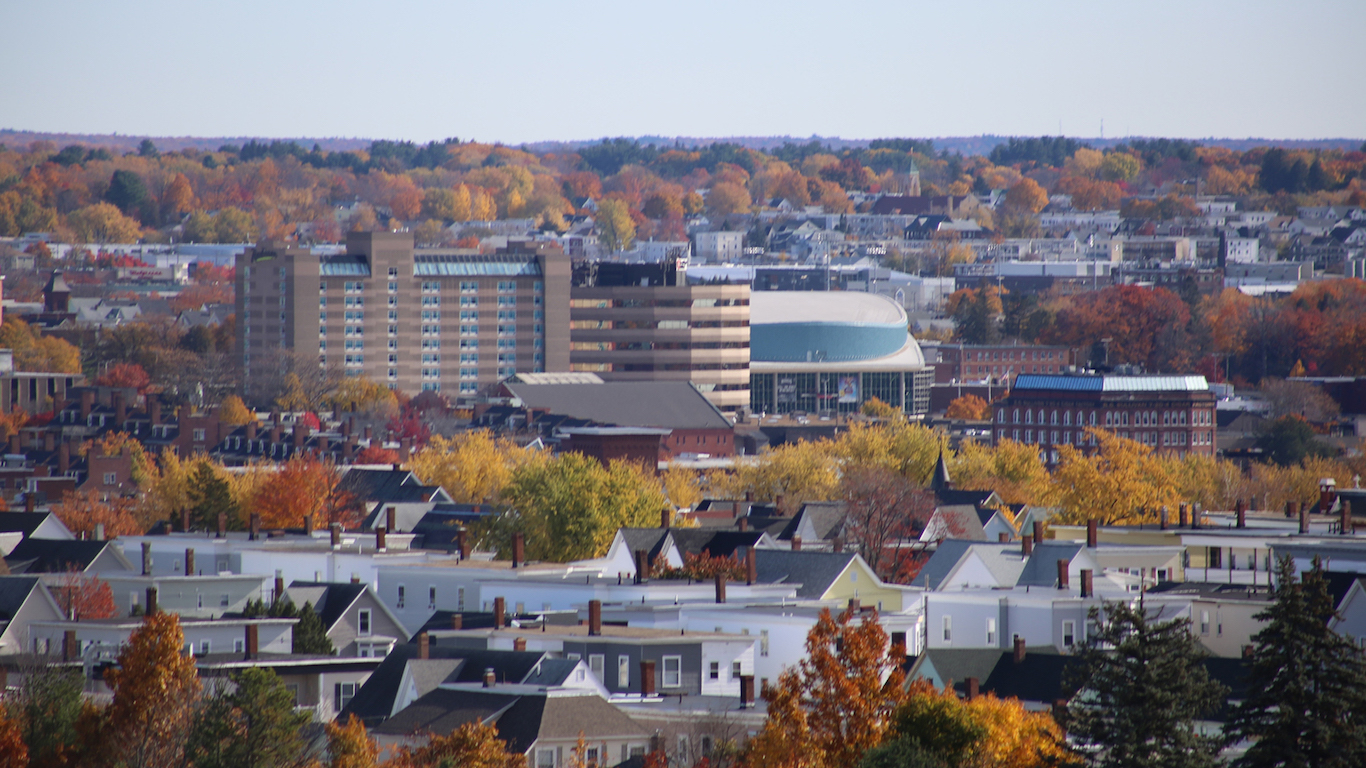
29. Manchester-Nashua, New Hampshire
> Premature death rate: 310.3 per 100,000
> Adult obesity rate: 28.1%
> Adult smoking rate: 15.2%
> Median household income: $76,254
While Manchester-Nashua is the only metro area in New Hampshire and is the least healthy city by default, several of its health measures are in line with the state as a whole. In both the city and the state, 20.6% of adults report no leisure-time physical activity, less than the 23.0% national inactivity rate. Some 28.1% of adults in Manchester are obese, compared to 27.9% of adults throughout New Hampshire and 28.0% of adults nationwide.
Nationwide, 16.0% of U.S. adults report fair or poor health, compared with 12.6% of adults in Manchester and 13.6% throughout New Hampshire. Every year, 310 in every 100,000 Manchester residents die before age 75, slightly more than the state premature mortality rate of 302 per 100,000 residents and less than the national rate of 336 per 100,000.
[in-text-ad-2]
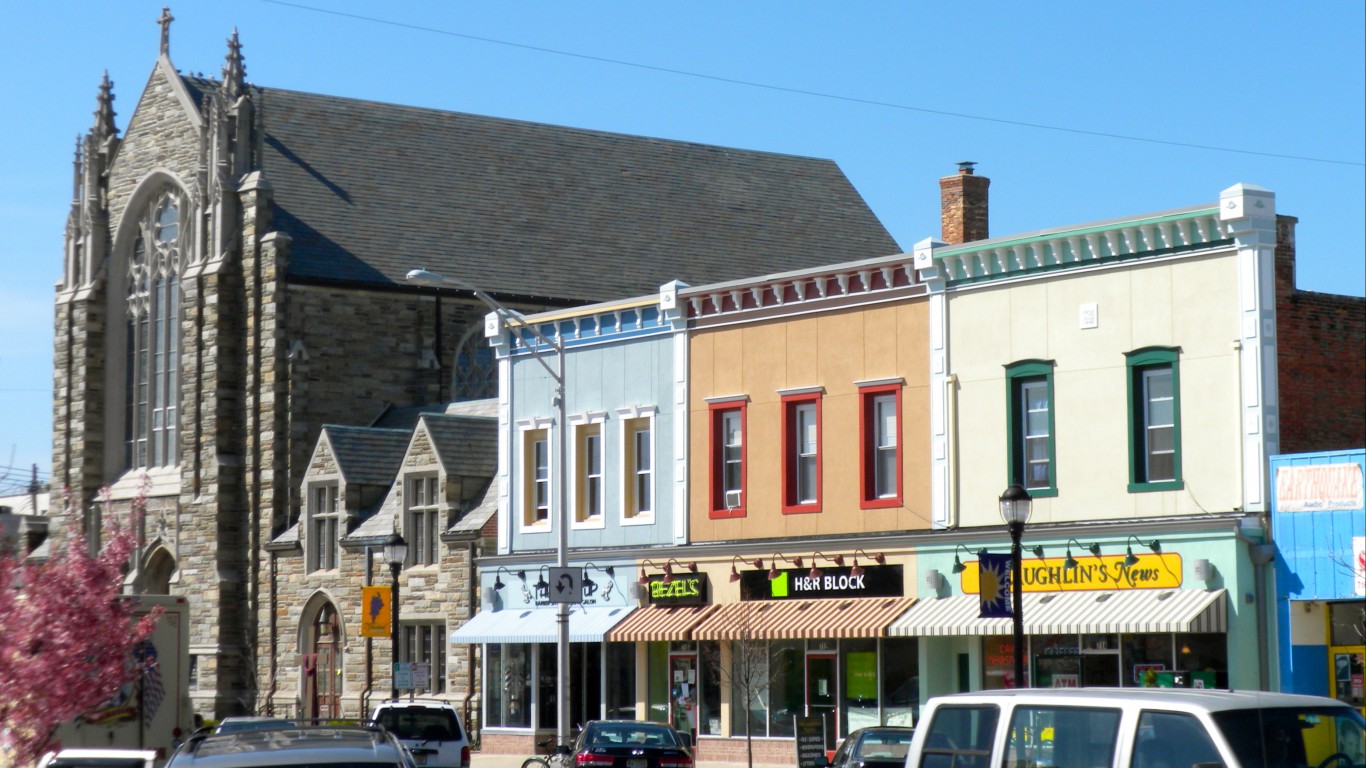
30. Vineland-Bridgeton, New Jersey
> Premature death rate: 434.2 per 100,000
> Adult obesity rate: 34.7%
> Adult smoking rate: 17.2%
> Median household income: $49,110
Of the four metro areas in New Jersey, Vineland-Bridgeton is the least healthy, reporting some of the worst health behaviors and outcomes. New Jersey reports some of the worst income inequality nationwide. This inequality contributes to large health disparities throughout the state. The median household income in Vineland-Bridgeton is $49,110 per year, about $28,500 less than what the typical household earns in Trenton, New Jersey’s wealthiest metro area. Approximately 19% of people live in poverty in Vineland-Bridgeton, far more than the 14.0% of residents who live in poverty statewide.
Health outcomes parallel the distribution of income in New Jersey. Nearly 35% of adults in Vineland-Bridgeton are obese, the highest share of cities in the state and well above the 25% of adults who are obese in Trenton and the nationwide rate at 28%. Every year, 434 in every 100,000 residents die before age 75, a lower premature death rate than the state rate of 283 premature deaths per every 100,000 residents.

31. Farmington, New Mexico
> Premature death rate: 444.3 per 100,000
> Adult obesity rate: 31.6%
> Adult smoking rate: 18.5%
> Median household income: $52,003
Farmington is by far the least healthy city in New Mexico. Some 18.5% of adults smoke, 23.7% do not exercise, and 31.6% are obese, each the largest share in New Mexico and higher than the statewide smoking rate of 16.6%, inactivity rate of 19.4%, and obesity rate of 24.4%. Smokers are more than 25 times as likely to get lung cancer than non-smokers, and are at a greater risk of dying prematurely. Additionally, adults who exercise seven hours a week are 40% less likely to die prematurely than those engaging in less than 30 minutes of exercise per week.
Farmington adults report an average of 4.5 mentally unhealthy days and 4.6 physically unhealthy days per month, each the most of any city in the state and among the most of any metro area nationwide. Every year, 444 in every 100,000 residents die before age 75, far greater than the state premature mortality rate of 385 deaths per 100,000 New Mexico residents and the highest of cities in the state.
[in-text-ad]

32. Elmira, New York
> Premature death rate: 368.2 per 100,000
> Adult obesity rate: 33.3%
> Adult smoking rate: 20.6%
> Median household income: $51,269
Elmira is the least healthy city in New York by a number of health metrics. Adults in Elmira report the greatest average number of physically and mentally unhealthy days per month in the state, at 4.1 and 4.2. Also, 20.6% of adults in Elmira smoke, the highest smoking rate of cities in the state. One-third of adults in this city are obese, more than any other New York metro area. All of these factors likely contribute to a higher premature death rate. For every 100,000 residents in Elmira, some 368 die before age 75, the highest premature death rate of cities in the state, and well above the statewide rate of 278 premature deaths per 100,000 residents.

33. Rocky Mount, North Carolina
> Premature death rate: 473.6 per 100,000
> Adult obesity rate: 35.5%
> Adult smoking rate: 19.6%
> Median household income: $38,972
The typical Rocky Mount household earns just $38,972 a year, far less than the statewide median household income of $50,584 a year and the least of any metro area in the state. Some 17.8% of city residents live in poverty, far more than the 15.4% state poverty rate.
While the relationship is complicated, poorer areas tend to report worse behaviors and, ultimately, worse health outcomes. Some 28.3% of Rocky Mount adults do not exercise, and 35.5% are obese — each the second largest share of cities in the state. Every year, 474 in every 100,000 residents die before age 75, by far the highest premature mortality rate in North Carolina.

34. Grand Forks, North Dakota
> Premature death rate: 301.8 per 100,000
> Adult obesity rate: 32.9%
> Adult smoking rate: 17.2%
> Median household income: $48,671
While Grand Forks may be regarded as the the least healthy city in North Dakota, it is healthier than a handful of U.S. cities by a considerable number of health metrics. Adults in Grand Forks report an average of 3.3 physically unhealthy days per month, the highest figure of cities in the state, but less than the national average of 3.7 days per month. Similarly, adults in Grand Forks report 3.1 mentally unhealthy days per month, more than in any other metro area in North Dakota but well below the national figure of 3.8 days per month.
Grand Forks also has one of the lower premature death rates in the nation. Some 301 residents out of every 100,000 die before age 75 in Grand Forks, compared to 336 premature deaths per 100,000 Americans nationwide.
[in-text-ad-2]

35. Springfield, Ohio
> Premature death rate: 507.2 per 100,000
> Adult obesity rate: 32.6%
> Adult smoking rate: 22.0%
> Median household income: $46,811
Springfield is the least healthy metro area in Ohio, and one of the least healthy cities nationwide. Every year, 507 in every 100,000 residents die before age 75, the highest premature mortality rate in the state and the eighth highest nationwide. Adults in the city report an average of 4.1 physically unhealthy days per year, the most of any city in Ohio and among the most of any U.S. metro area.
The presence of negative health behaviors in Springfield likely contributes to the city’s poor health outcomes. Some 22.0% of adults in Springfield smoke, the highest smoking rate in Ohio and the 10th highest in the nation. Smokers are more than 25 times as likely to get lung cancer than non-smokers, and are at a greater risk of dying prematurely. Additionally, 27.2% of adults report no leisure-time physical activity, far more than the 22.5% state inactivity rate. Adults who exercise seven hours a week are 40% less likely to die prematurely than those engaging in less than 30 minutes of exercise per week.

36. Lawton, Oklahoma
> Premature death rate: 471.4 per 100,000
> Adult obesity rate: 35.6%
> Adult smoking rate: 20.5%
> Median household income: $50,980
Not only is Lawton the least healthy city in Oklahoma, but also it is considered one of the least healthy places on a national level. Nearly one in five of adults in Lawton report they are in fair or poor health, and about the same amount smoke, both the highest shares of any city in the state and well above the respective national shares of 16.0% and 17.0%. Some 30.7% of adults in Lawton lead sedentary lifestyles, the 23rd highest inactivity rate nationwide.
Poor health behaviors tend to increase the risk of poor health outcomes. In Lawton, 35.6% of adults are obese, the 22nd largest share nationwide, and the second largest share in Oklahoma after Enid, where 37.6% of adults are obese.
[in-text-ad]

37. Grants Pass, Oregon
> Premature death rate: 421.7 per 100,000
> Adult obesity rate: 27.8%
> Adult smoking rate: 18.3%
> Median household income: $36,472
Grants Pass is a metro area of approximately 86,000 residents located in the southwest corner of Oregon. The typical household in Grants Pass earns just $36,472 a year, the least of any city in the state and the third least of any metro area nationwide.
Poorer areas tend to report worse health outcomes than wealthier areas, and Grants Pass has the worst health outcomes of cities in the state. Some 17.1% of adults in Grants Pass report being in fair or poor health, the largest share in Oregon and greater than the 15.8% of adults who do statewide. Some 422 in every 100,000 residents die before age 75, the highest premature mortality rate of cities in the state and far higher than the statewide rate of 310 premature deaths per 100,000 Oregon residents.

38. Johnstown, Pennsylvania
> Premature death rate: 435.3 per 100,000
> Adult obesity rate: 30.2%
> Adult smoking rate: 17.3%
> Median household income: $44,100
Of the 18 metro areas in Pennsylvania, Johnstown, which is east of Pittsburgh, is the least healthy. The premature death rate in Johnstown is not only the highest of cities in the state, but also one of the highest in the nation. For every 100,000 residents, 435 die before age 75, far higher than the nationwide premature death rate of 336 per 100,000.
A number of environmental and socioeconomic factors may contribute to the negative health outcomes in Johnstown. Only 58.7% of adults in in this metro area have access to a recreational facility or park where they can exercise, one of the lowest shares in the nation and well below the already low statewide share of 67.8%. Poorer households tend to report worse health outcomes because of inadequate access to health care and healthy foods, for example. The typical household in Johnstown earns just $44,100 a year, the second lowest median income of any city in the state and one of the lowest nationwide.

39. Providence-Warwick, Rhode Island
> Premature death rate: 314.8 per 100,000
> Adult obesity rate: 27.9%
> Adult smoking rate: 16.2%
> Median household income: $61,948
Providence-Warwick is the lone metro area in Rhode Island and therefore, by default, the least healthy. The metro area is actually among the healthier metros nationwide, with smoking and obesity rates below the national rates. The typical metro area household earns $61,948 per year, above the national annual median of $57,617. This could contribute to residents having better access to health care and healthy food. In addition, 91.1% of residents have access to a gym, park, or another kind exercise facility, significantly above the national share of 83.0%.
[in-text-ad-2]

40. Florence, South Carolina
> Premature death rate: 511.8 per 100,000
> Adult obesity rate: 35.9%
> Adult smoking rate: 19.8%
> Median household income: $42,200
Of the eight metro areas in South Carolina, Florence is the least healthy city and arguably one of the least healthy in the nation. Nearly 36% of adults in Florence are obese, well above the statewide obesity rate of 32% and the national rate of 28%. In addition, 12.6% of babies born in the city have a low birth weight — less than 5.5 pounds — the fourth highest share in the nation.
Adults in Florence are more likely to feel physically and mentally unhealthy throughout the month than adults in most other cities, and 21.6% say they are in fair or poor health. Perhaps the most alarming health metric in Florence is the premature death rate. For every 100,000 residents, 512 die before age 75, the seventh highest rate of cities nationwide.

41. Rapid City, South Dakota
> Premature death rate: 302.1 per 100,000
> Adult obesity rate: 27.2%
> Adult smoking rate: 15.5%
> Median household income: $51,097
Rapid City is one of two metro areas in South Dakota and, for a number of reasons, it is the least healthy of the two. Still, Rapid City is actually healthier than several U.S. cities. For example, adults in Rapid City are less likely to be obese, smoke, and are more likely to be physically active than the typical American. Adults in the city also report some of the lowest physically and mentally unhealthy days per month of U.S. cities. Only 12.6% of adults report they are in fair or poor health, well below the 16.0% of adults that report the same nationwide.
The premature death rate is usually a strong indicator of health of a community, and in Rapid City, the premature death rate falls considerably below the national rate. For every 100,000 residents, 302 die before age 75, which is less than the national rate of 336 premature deaths for every 100,000.
[in-text-ad]

42. Memphis, Tennessee
> Premature death rate: 460.0 per 100,000
> Adult obesity rate: 33.1%
> Adult smoking rate: 20.3%
> Median household income: $49,809
Violent crime and poverty can induce mental and physical stress, discourage physical activity, and contribute to worse health outcomes overall. There were 1,082 violent crimes reported per 100,000 residents in the Memphis metro area in 2016, the highest violent crime rate in Tennessee and the third highest of any U.S. city. Additionally, some 30.1% of children in the city live in poverty, the highest child poverty rate of cities in the state and far higher than the national rate of 20.0%.
Memphis reports some of the worst health outcomes nationwide. Some 11.0% of babies are born with low birthweight, the largest share of cities in Tennessee and the 11th largest share of cities nationwide. Every year, 460 in every 100,000 residents die before age 75, the third highest premature death rate of cities in Tennessee and far above the national rate of 336 premature deaths per 100,000 Americans.

43. Texarkana, Texas
> Premature death rate: 489.9 per 100,000
> Adult obesity rate: 34.9%
> Adult smoking rate: 19.3%
> Median household income: $42,513
There are 25 metro areas in Texas, and Texarkana is the least healthy for a variety of reasons. Of area adults, 34.9% are obese and 19.3% smoke, both the largest shares of cities in the state. Only 50.6% of adults have access to a recreational facility or park, the lowest share in the state. This likely plays a role in the 34.6% of adults who are physically inactive, which is the largest share of cities in the state and the third largest share of U.S. cities. Overall, Texarkana has one of the highest premature death rates in the nation. For every 100,000 residents, 490 die before age 75, the highest rate in the state and the 17th highest nationwide.
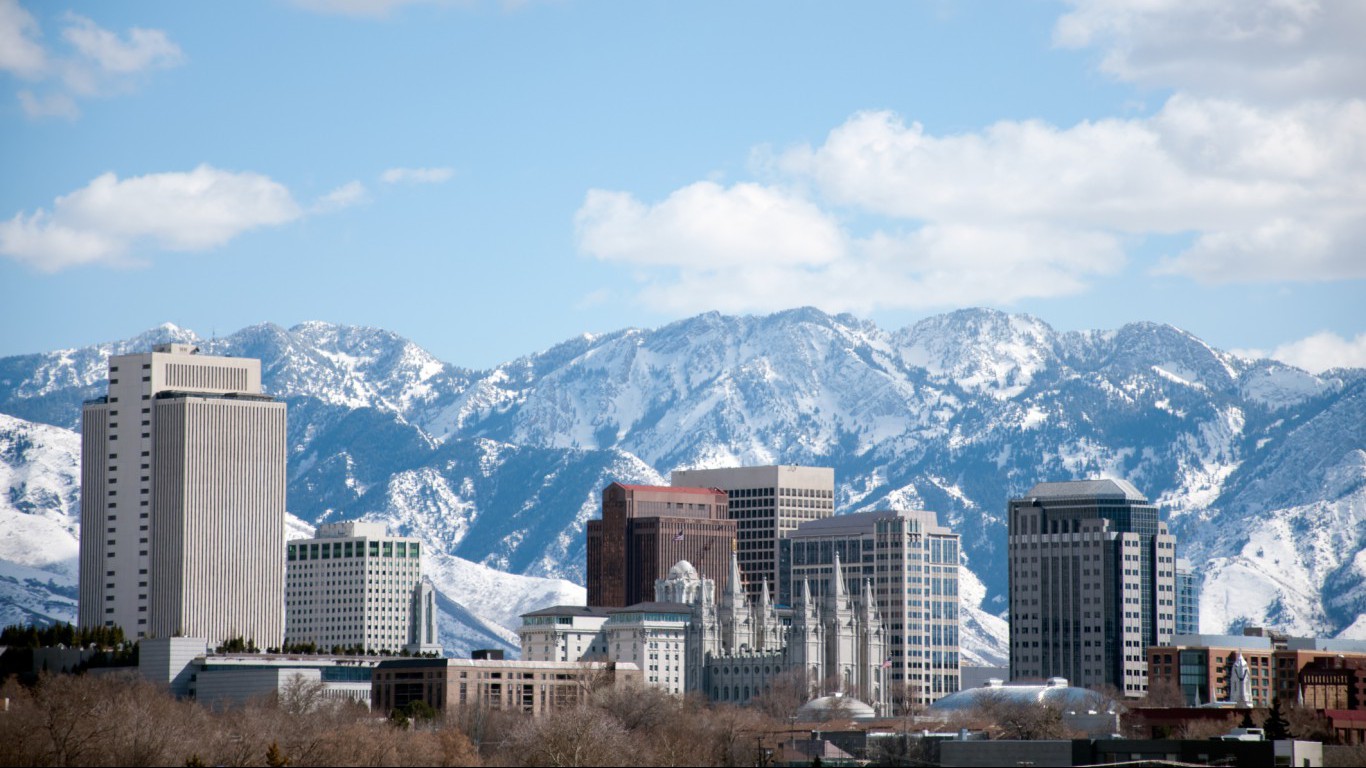
44. Salt Lake City, Utah
> Premature death rate: 310.5 per 100,000
> Adult obesity rate: 25.3%
> Adult smoking rate: 9.5%
> Median household income: $68,196
While Salt Lake City is the least healthy metro area in Utah, residents are better off than the average American by a number of health metrics. While the smoking rate of 9.5% is the highest of any metro area in the state, it is still far less than the national smoking rate of 17.0%. Similarly, 7.5% of babies in Salt Lake City are born with low birthweight, the largest share in the state yet less than the 8.0% national figure.
Some 12.2% of adults report fair or poor health, the largest share in Utah and less than the 16.0% national share. Every year, 311 in every 100,000 residents die before age 75, the highest premature death rate of cities in Utah but still below the national rate of 336 premature deaths per 100,000 Americans.
[in-text-ad-2]

45. Burlington-South Burlington, Vermont
> Premature death rate: 275.6 per 100,000
> Adult obesity rate: 21.7%
> Adult smoking rate: 13.0%
> Median household income: $66,367
Burlington-South Burlington is the only metro area in Vermont, which makes it the least healthy city by default. City residents, however, are better off than state residents as a whole in a number of health metrics. Just 10.5% of residents report fair or poor health, less than the 12.5% state figure and the fifth smallest share of any metro area nationwide. Similarly, just 17.5% of adults report no leisure-time physical activity, and only 21.7% are obese — far lower than the state and national inactivity and obesity rates. Every year, 276 in every 100,000 residents die before age 75, less than the state premature mortality rate of 291 per 100,000 Vermont residents and the national rate of 336 per 100,000 Americans.

46. Roanoke, Virginia
> Premature death rate: 386.8 per 100,000
> Adult obesity rate: 28.7%
> Adult smoking rate: 16.5%
> Median household income: $50,551
Roanoke is the least healthy city in Virginia largely because it has the highest premature death rate in the state. For every 100,000 residents, 387 die before age 75, a higher rate than the state rate of 317 premature deaths per every 100,000 people. Aside from the mortality rate, Roanoke is relatively healthy in comparison with the average U.S. city. For example, adults in report 3.7 mentally unhealthy days and 3.5 physically unhealthy days per month, both below their respective national figures.
[in-text-ad]

47. Yakima, Washington
> Premature death rate: 359.3 per 100,000
> Adult obesity rate: 30.9%
> Adult smoking rate: 15.2%
> Median household income: $48,965
While Bellingham, Seattle, and Kennewick, Washington, are some of the healthiest metro areas in the country, the state is also home to one of the least healthy metro areas in the nation. In Yakima, 21.2% of residents report fair or poor health, the largest share of cities in the state and far above the 16.0% national share. Adults report an average of 4.1 mentally unhealthy days and 4.4 physically unhealthy days per month, the most of any city in the state and far more than the corresponding national figures.
People earning higher incomes have greater access to health care, can afford healthier food, may have more time to exercise, and have better health outcomes overall. The typical household in Yakima earns $48,965 a year, the lowest median household income of any city in Washington and less than the state median of $67,106 and national median of $57,617.
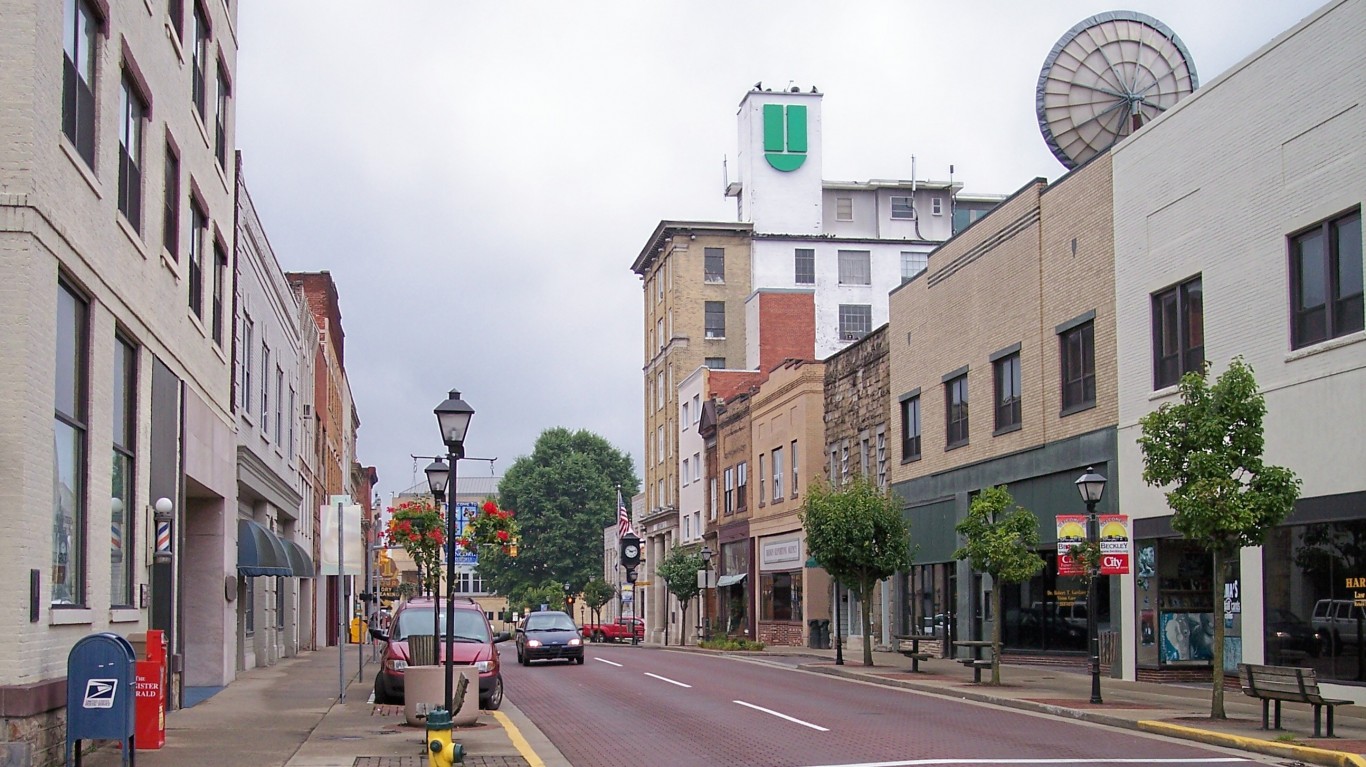
48. Beckley, West Virginia
> Premature death rate: 580.4 per 100,000
> Adult obesity rate: 36.8%
> Adult smoking rate: 24.3%
> Median household income: $44,178
Beckley reports the worst health behaviors and outcomes in West Virginia and some of the worst in the nation. One in four adults report they are in fair or poor health, the largest share in the state and the ninth largest share nationwide. Adults in Beckley also report the highest number of physically and mentally unhealthy days per month of any U.S. city, at 5.4 and 5.5 days, respectively. In addition, some 24.3% adults smoke, the highest smoking rate both statewide and nationwide.
Perhaps the most alarming health metric in Beckley is the premature death rate. For every 100,000 people, 580 die before age 75 in Beckley, the highest premature death rate in the nation and well above the national rate of 336 premature deaths per every 100,000 people.

49. Milwaukee-Waukesha-West Allis, Wisconsin
> Premature death rate: 335.5 per 100,000
> Adult obesity rate: 30.7%
> Adult smoking rate: 16.2%
> Median household income: $58,029
The Milwaukee-Waukesha-West Allis metro area reports some of the worst health outcomes in Wisconsin. Adults in the area report 3.8 mentally unhealthy days a month, in line with the state and national averages, but the highest of any Wisconsin metro area.
Milwaukee-Waukesha-West Allis also has a higher incidence of violent crime, which can induce physical and mental stress, discourage physical activity, and contribute to worse health outcomes overall. In 2016, there were 656 violent crimes reported per 100,00 residents in this metro area, one of the highest violent crime rates in the nation. The metro area also has the highest rate of Chlamydia in the state and one of the highest in the nation at 677 incidents per 100,000 people.
[in-text-ad-2]

50. Casper, Wyoming
> Premature death rate: 391.1 per 100,000
> Adult obesity rate: 31.3%
> Adult smoking rate: 16.9%
> Median household income: $59,474
Casper is the less healthy of the two metro areas in Wyoming. Some 24.2% of adults in Casper report no leisure-time physical activity compared to the 23.7% in the Cheyenne metro area, and 31.3% of adults in Casper are obese compared to 30.5% in Cheyenne. Adults in Casper report an average of 3.8 mentally unhealthy days per month, compared to 3.5 days in Cheyenne. Every year, 391 in every 100,000 residents in Casper die before age 75, compared to 360 in Cheyenne. The premature death rate nationwide is 336 deaths per 100,000 Americans.
While the relationship between money and health is complicated, poorer areas tend to have worse health outcomes. The typical household in the Casper metro area earns $59,474 a year, slightly less than the annual median household income of $62,221 in the Cheyenne metro area.
Detailed Findings
In some of the healthiest states, even residents of the least healthy city are better off than the average American by a number of health metrics. In Hawaii, for example, an average of 276 in every 100,000 residents die before age 75 each year, the fourth lowest premature mortality rate of any state. While the Kahului-Wailuku-Lahaina metro area is the least healthy metro area in the state, its premature death rate of 275 per 100,000 is still far below the national rate of 336 premature deaths per 100,000 Americans. In 16 states the premature death rate in the least healthy city is still below the national figure.
Our findings show that the health behaviors that are most correlated with premature mortality at the metropolitan level are smoking, a lack of exercise, and obesity. Smokers are more than 25 times as likely to develop lung cancer than non-smokers, and are at a greater risk of dying prematurely. Additionally, adults who exercise seven hours a week are 40% less likely to die prematurely than those engaging in less than 30 minutes of exercise per week. In 49 of the 50 cities with the highest incidence of premature death, the share of adults who report no leisure-time physical activity is greater than the 23.0% national figure.
People earning higher incomes have greater access to health care, can better afford healthy food, and may have more time to exercise. Due to these and other factors, more affluent individuals have better health outcomes overall. In all 50 of the cities with the highest premature mortality rates nationwide, the typical household earns less than the national annual median household income of $57,617. Socioeconomic factors included in our index that are the most correlated with the premature mortality rate include median household income, the share of children living in single-parent households, the share of children living in poverty, and the food insecurity rate.
Methodology
To determine the least healthy city in every state, 24/7 Wall St. created an index composed of 35 health outcomes and health factors with data from the 2018 County Health Rankings & Roadmaps, a joint program of the Robert Wood Johnson Foundation and the University of Wisconsin Population Health Institute. County-level data was aggregated to the metropolitan statistical area level using five-year population estimates from the U.S. Census Bureau’s American Community Survey for 2011 to 2016. Health outcomes with the heaviest weights in the index include the age-adjusted premature mortality rate, the percentage of births with low birthweight, the percentage of adults reporting fair or poor health, and the average number of mentally and physically unhealthy days per month reported by the adult population. Health factors with the heaviest weights in the index include the smoking rate, the 2017 unemployment rate, and the child poverty rate.
If you missed out on NVIDIA’s historic run, your chance to see life-changing profits from AI isn’t over.
The 24/7 Wall Street Analyst who first called NVIDIA’s AI-fueled rise in 2009 just published a brand-new research report named “The Next NVIDIA.”
Click here to download your FREE copy.
Thank you for reading! Have some feedback for us?
Contact the 24/7 Wall St. editorial team.